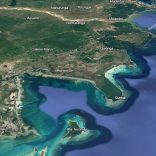Mozambique: President Chapo calls for air links between African countries
Government forecasts growth of 5.5 percent for 2017 in Mozambique

The Mozambican government’s Economic and Social Plan for 2017, introduced by Prime Minister Carlos Agostinho do Rosario in the country’s parliament, the Assembly of the Republic, on Wednesday envisages annual economic growth of 5.5 per cent.
The target growth rate for 2016 was seven per cent. Although the final figures are not yet available, the current forecast is that growth this year has slumped to 3.9 per cent.
The main driver of growth in 2017 is expected to be the extractive industry with a forecast growth rate of 24 per cent (compared with an estimated 13.2 per cent this year). The revival in international coal prices is expected to lead to an increase in the amount of coal mined from 7.8 million tonnes this year to rather more than 11 million tonnes in 2017.
The vast reserves of gas in the Rovuma Basin, in the far north, will not come on stream for several more years, but the plan projects an increase of 4.4 per cent in the gas extracted in the Pande and Temane fields in the southern province of Inhambane, operated by the South African petro-chemical giant, Sasol. The same fields produce condensate, or light oil, and production is expected to increase by 21 per cent.
The dredge mine at Moma, in the northern province of Nampula, operated by the Irish company Kenmare Resources, is expected to increase very substantially its production of titanium ores. Production of the main ore, ilmenite (titanium iron oxide) will more than double, from just under 600,000 tonnes this year to a projected 1.28 million tonnes in 2017.
Agricultural and livestock production is expected to rise by 5.9 per cent. But the target for grain production is a rise of 14 per cent. The forecast is that maize production will rise from about 1.8 million tonnes this year to just over two million tonnes in 2017.
A 25 per cent increase in rice production is expected so that the 2017 rice harvest will be 413,000 tonnes, compared with 331,000 tonnes this year.
As for root crops, cassava production is expected to grow by 20 per cent, from 9.1 million tonnes this year, to 10.92 million tonnes in 2017. The rise in sweet potato production should be 12 per cent, from 1.6 million to 1.8 million tonnes.
Turning to cash crops, the plan forecasts a 28 per cent increase in sugar cane production, a 19 per cent increase in cotton, and a 15 per cent increase in cashew nuts.
The output from manufacturing industry is forecast to rise by 5.8 per cent, while electricity production should rise by 16 per cent.
Fishery production should rise by 4.4 per cent. The most important commercial fishery resource is prawns and production is expected to rise by 15 per cent, from around 3,000 tonnes this year to 3,435 tonnes in 2017.
The section in the plan on fisheries makes no mention at all of the Mozambique Tuna Company (Ematum), the company which acquired 24 fishing boats in 2013-14 as part of an 850 million dollar loan from European banks, illicitly guaranteed by the government.
Instead the Beira-based company Pescamoz will fish for tuna with just six boats. AIM asked the Minister of the Sea, Inland Waters and Fisheries, Agostinho Mondlane, if these were Ematum boats on loan to Pescamoz. He said he did not know, and that such matters were dealt with between the companies with no intervention from his ministry.
It is almost certain that these are indeed Ematum boats, since the possibility of farming out the Ematum boats to Pescamar was mentioned in August, during the Maputo International Trade Fair (FACIM). This means that the other 18 Ematum boats may well lie idle throughout 2017.
With the Pescamar deal, commercial tuna fishing by Mozambican boats is expected to rise from 417 tonnes this year to 900 tonnes in 2017. This is dwarfed by the foreign vessels licensed to fish for tuna in Mozambican waters. Their catch is expected to rise by 60 per cent from 3,193 tonnes this year to 5,100 tonnes.
Ironically, Mozambican artisanal fishermen, who never thought of asking for a loan of 850 million dollars, catch much more tuna than Ematum. The artisanal tuna catch this year was 2,050 tonnes, and is predicted to reach 2,762 tonnes in 2017.












Leave a Reply
Be the First to Comment!
You must be logged in to post a comment.
You must be logged in to post a comment.